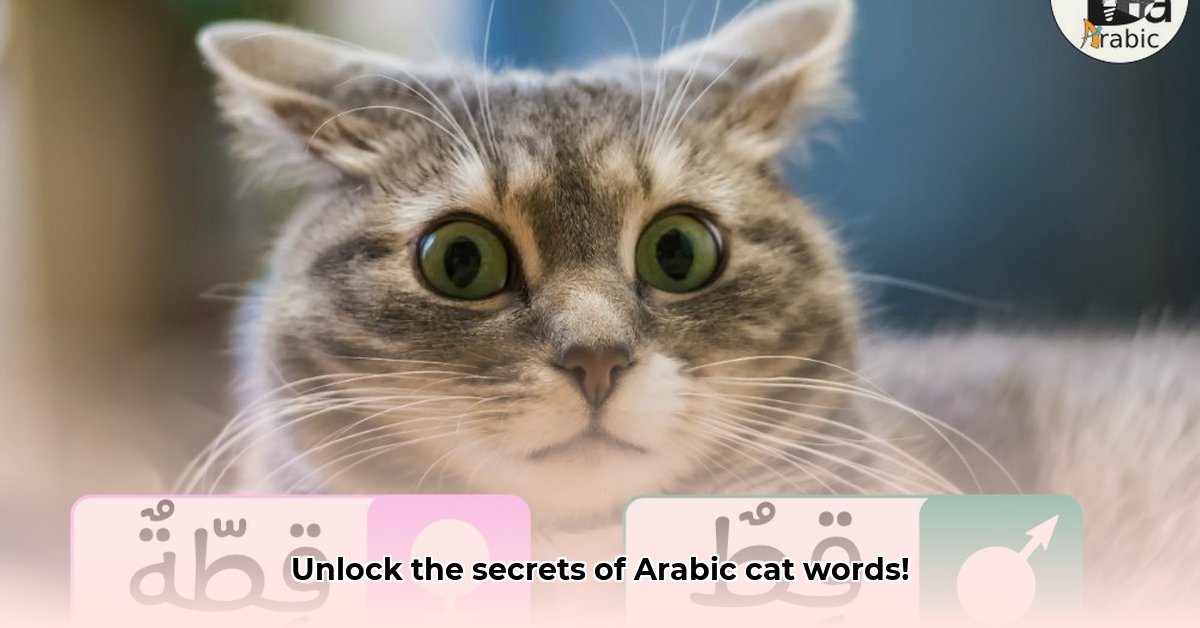Ever wondered how many ways there are to say “cat” in Arabic? Prepare to be amazed! This guide unveils the diverse vocabulary surrounding our feline friends, exploring everything from formal terms to everyday expressions used in different corners of the Arab world. Want to learn more about family terms? Check out this guide on how to say brother in Arabic. We’ll delve into pronunciation nuances, provide practical examples, and clarify gender-specific terms. Whether you’re a language enthusiast, translator, or simply curious about the world, this comprehensive guide will transform you into an Arabic cat-word connoisseur. Let’s embark on a purr-fectly fascinating journey through the world of Arabic cat vocabulary!
Cat in Arabic: A World of Words
The Arabic language offers a rich tapestry of words for “cat,” each carrying its own subtle shades of meaning and reflecting regional variations. Delving into these nuances unlocks a deeper understanding of the language and its cultural context.
More Than One Way to Say “Meow”
Just as English boasts multiple ways to refer to a cat (kitty, feline, etc.), Arabic offers a variety of terms, influenced by factors such as gender, formality, and geographical location. To navigate this linguistic landscape, it’s helpful to distinguish between Modern Standard Arabic (MSA) and colloquial dialects.
Modern Standard Arabic (MSA) serves as the formal, written language used in literature, media, and official communication. In MSA, the most common term for a female cat is قِطَّة (qitta), pronounced approximately as “kit-ta.” For a male cat, the term قط (qitt), pronounced similarly to “kit,” is generally used.
However, Arabic is renowned for its diverse dialects, which vary significantly from region to region. The Arabic spoken in Cairo can sound markedly different from that spoken in Marrakech, and this linguistic diversity extends to the vocabulary used for everyday objects, including our beloved feline companions. While MSA provides a solid foundation, it’s essential to explore the fascinating world of colloquial variations. Some Arabic dialects even incorporate loanwords from languages such as French or Spanish, reflecting historical and cultural influences.
The Gender Game: Navigating Masculine and Feminine Nouns
In Arabic, nouns are typically assigned a grammatical gender – masculine or feminine. This distinction also applies to the word “cat,” and using the incorrect gender can sound awkward to native speakers. While MSA clearly distinguishes between male (قط – qitt) and female (قِطة – qitta) cats, some dialects exhibit greater flexibility, with the surrounding context often clarifying the intended gender. A solid understanding of these grammatical concepts enhances communication precision and fluency.
Regional Variations: A World Tour of Cat Words
The words used for “cat” can vary dramatically across different regions of the Arab world. The term used in Egypt may differ significantly from that used in Morocco, underscoring the richness and diversity of the language and the unique evolution of its dialects. Here’s a glimpse into some of the regional variations:
| Region | Possible Word(s) for “Cat” | Notes |
|---|---|---|
| Egypt | قطة (qitta), قط (qitt), بسة (bissa) | Generally similar to MSA, but pronunciation can vary slightly. “Bissa” is a common colloquial term. |
| Levant (Syria, Lebanon, Jordan, Palestine) | قطة (qitta), قط (qitt), بسينة (bseeneh) | Several colloquialisms exist; it’s a diverse region with various dialects. “Bseeneh” or “Bseen” are common in certain areas. |
| Gulf (UAE, Saudi Arabia, Kuwait, Qatar, Bahrain, Oman) | قطة (qitta), قط (qitt), بسة (bissa) | Significant dialect differences lead to distinct terms for “cat.” “Bissa” is also used, and variations in pronunciation are common. |
| Morocco (Maghreb) | قط (qett), قطوسة (qattusa), مش (mish) | Dialectal variations are substantial; expect entirely different words. “Qattusa” and “Qattus” are common, and “Mish” is a widely understood term. |
Important Note: This table provides an overview of regional diversity. Numerous sub-dialects and variations exist within each region, making the linguistic landscape incredibly complex.
Pronunciation: More Than Meets the Eye
Written Arabic can present pronunciation challenges, as the same letters can sound different depending on the dialect. Accurately pronouncing Arabic words requires careful attention to regional variations and the nuances of each sound. Fortunately, a wealth of online resources, including language-learning apps and audio dictionaries, are readily available to assist learners. Mastering correct pronunciation is crucial for effective communication, as mispronunciation can lead to misunderstandings.
Context is King: Formal vs. Informal Speech
As in any language, the context of a conversation dictates the appropriate level of formality. Using MSA when conversing with close friends might sound overly formal and unnatural, while using slang when addressing a superior could be deemed inappropriate. Understanding the social context – who you’re speaking to and the situation – is essential for selecting the right word and tone.
Your Arabic Cat Word Adventure Awaits!
Embarking on a journey to discover the various ways to say “cat” in Arabic is like uncovering a hidden treasure, revealing a deeper understanding of the language, its history, and its diverse dialects. Embrace the challenge and celebrate the uniqueness of each regional variation. Your Arabic language skills will undoubtedly benefit from this exploration. The more you learn, the more you’ll appreciate the dynamic and multifaceted nature of the Arabic language. And who knows, you might even spark a conversation with a furry friend along the way! Want to learn more animal names in Arabic?
How to Pronounce Arabic Cat Words Across Different Dialects: A Pronunciation Guide
Key Takeaways:
- The formal Arabic term for “cat” is qiṭṭa (قِطّة).
- Pronunciation varies widely across dialects.
- Understanding regional variations is essential for effective communication.
- Mastering gendered terms enhances fluency and precision.
Mastering the Formal Term: Qiṭṭa (قِطّة)
Let’s begin with the cornerstone of Arabic vocabulary: Modern Standard Arabic (MSA). As previously mentioned, the word for “cat” in MSA is qiṭṭa (قِطّة). But how do you pronounce it accurately?
The “q” represents a voiceless uvular stop, a sound not commonly found in English. To produce this sound, try making a sound deep in the back of your throat, similar to the “k” sound but further back. The “i” is pronounced like the “i” in “machine” or the “ee” in “see.” Next, “ṭ” is a voiceless emphatic alveolar stop; it’s a strong, slightly “rolled” T sound produced by pressing the tongue against the alveolar ridge (the gum ridge behind your upper teeth). Finally, the “a” is a short “ah” sound, similar to the “a” in “father.” To master the pronunciation of qiṭṭa, practice saying it slowly and deliberately, gradually increasing your speed as you become more comfortable with the sounds.
Delving into Dialectal Variations: A World of Pronunciation
The beauty and challenge of Arabic lie in its regional dialects, each with its own unique pronunciation patterns and vocabulary. What’s called a “cat” in one region might sound entirely different elsewhere.
For example, in Egyptian Arabic, you might encounter the term bissa (بِسَّة). This word often carries a softer, more playful connotation. Fortunately, pronouncing bissa is generally easier for English speakers, as the sounds are more familiar. The “b” is pronounced as in “ball,” the “i” as in “machine,” “s” as in “sun,” and the final “a” as in “father.”
In Levantine Arabic (spoken in countries like Lebanon, Syria, Jordan, and Palestine), you might hear quṭṭa (قُطّة). Note the subtle difference from the MSA qiṭṭa: the short “i” in qiṭṭa becomes a short “u” in quṭṭa. These slight variations in vowel sounds are common across dialects.
Other regional variations include qattusa (قطوسة) in certain North African dialects, highlighting the rich tapestry of Arabic.
Gender Matters: Male vs. Female Cats in Pronunciation
In many dialects, the pronunciation of the word for “cat” can vary depending on the gender of the animal. While MSA typically uses qiṭṭa for both male and female cats, some colloquialisms differentiate. In certain dialects, a male cat might be referred to by a completely different term with its own unique pronunciation.
A Practical Guide: Pronunciation Tips and Resources
Learning how to pronounce Arabic cat words across different dialects requires dedicated practice and immersion. Here are some helpful tips:
- Listen and mimic: Seek out audio recordings of native speakers using the different terms. Pay close attention to their pronunciation and strive to imitate their sounds as accurately as possible.
- Break it down: Deconstruct each word phonetically. Pay attention to individual sounds, vowel qualities, and consonant articulations.
- Record yourself: Record yourself pronouncing the
















